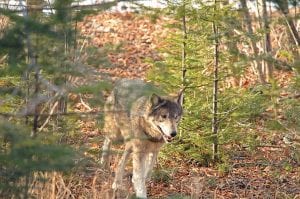It didn’t take hunters and trappers long to fill the Minnesota Department of Natural Resource’s late season wolf quota for Northeastern Minnesota. In just six days the DNR cancelled the hunt after 40 wolves had been taken. The quota was 35, but was exceeded on the last day the state ended the season. The early season was closed after hunters had killed 38 of 40 wolves, said DNR large carnivore specialist Dan Stark.
The northeast zone includes all of Cook and Lake county and portions of Carlton, St. Louis, and Aitkin county.
While the late season is closed here, it remained open in the northwestern zone until December 8 when 82 wolves were registered and as of press time the season was still open in the east central zone.
Hunters filled out the early season in record fashion this year, with all three zones closed early. When hunters come close to the quota the DNR cancels the season to keep the hunt within, or near, its allocation.
In its third year, the DNR released some statistics from the previous two hunts: Less than 5 percent of wolf hunters kill a wolf, with trappers having far more success than hunters using firearms. Trappers take 80 percent of wolves in the late season. Half of the wolves killed are male and female and half of all wolves taken are under two years old.
Unless quotas are met, trapping and hunting will continue in the east central zone until January 31.
Teeth from every wolf killed (and reproductive organs from females) are sent to the DNR to be studied, said Stark. Information gained from those studies will help the DNR learn more about wolf behavior and how the hunt affects wolf packs, he said.
Stark, who is stationed in Grand Rapids, said he didn’t have the breakdown yet of how many wolves were killed in each county, and where those wolves were taken.
“We get that information when wolves are brought in. We take teeth and reproductive organs to help us determine the age and health of the wolves. We also look to see if a wolf is diseased, has mange or has parasites when they are brought in.”
Stark said the DNR estimated there were about 2,200 wolves in Minnesota in 2013 and that count grew to 2,400 in 2014. He said the DNR would do another count this winter and determine whether there will be a wolf hunting/trapping season next year.
When asked about wolves coming into Grand Marais (and other townships) and going after dogs, Stark said Ely and Walker, Minnesota had similar situations, but these incidents tend to decline after a time.
“Wolves are pretty adaptable. If they don’t have a negative experience around people they can be pretty bold.”
He also said he doesn’t think wolves are targeting dogs as a food source, but instead see dogs as a threat to their territory.
“I don’t think they eat dogs. Well, they might eat them if they are hungry enough. But lots of times it could just be territorial issues. I don’t know if they are coming into town because it has to do with the deer population being down or just more wolves out there. Last winter there was good pup production. We’ve seen this happen in other communities, but it usually doesn’t last too long,” he said.



Loading Comments